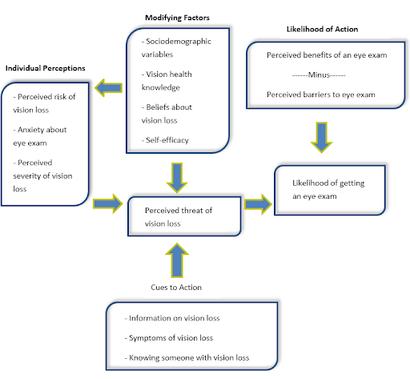
4 minute read
Prevention Of Vision Impairments in Colorado Latinx Populations
from RISE No. 2
Melissa Scofield
In the US, the Latinx population has disproportionate rates of eye disease and conditions, especially diabetic retinopathy and glaucoma (11) Nationally, 215% of Latinx aged 20 years and older have diabetes and estimates indicate 50% of individuals with glaucoma will be Latinx in 2050 (10, 2). Culturally competent programs acknowledge variances among diverse cultures and design services to meet the needs of distinct populations. Patientcentered health literacy focuses on preventive care to reduce health disparities by providing information and services necessary for individuals to make informed health decisions.
Advertisement
As rates of vision impairment among Latinx populations continue to rise, programs must incorporate culturally relevant preventive measures to improve vision health equity. The term Latinx is used to be inclusive to all people of Latin American descent, including those identifying as “Latino, Latina, or Hispanic” In 2021, the US Census Bureau estimated 223% of Colorado’s population identify as Hispanic or Latino Supporting Latinx community members in accessing eye care aims to decrease disparities in the utilization of vision care services and improve vision health outcomes.
Promoting health equity across all policies and programs is crucial Vision impairments and blindness reduce quality of life and increase economic burden; improving timely detection, management, and treatment is important to preserve vision health (4) Nearly 1 in 4 individuals living with blindness or vision loss is under the age of 40 (12). Adults across their lifespan differ in their perspectives of the importance of vision tests, individuals in their 20’s and 30’s often expressed they did not feel such tests were necessary because they were not experiencing any vision problem (6). As programs aim to address these issues, it’s imperative to implement continuous evaluation and modification processes Effective health promotions require a multi-pronged approach because health behaviors are complex and multi-faceted (7)

Vision Health Belief Model
The above model is adapted from the Health Belief Model. The perceptions, factors, and cues in the model predict health behavior change, illustrating the likelihood of an individual taking action.
Here, the behavioral objective is to increase participation in annual eye exams A 2018 report revealed adults participating in a vision screening study were unaware that they were living with poor vision, even those with very poor vision (ie, 20/50 on the Snellen scale) were often surprised at the results (6) The CDC estimates the number of individuals who are visually impaired or blind in the U.S. will triple by 2050 (3). Diabetic retinopathy early detection and treatment can prevent or delay blindness 90% of the time, however 50% of cases are diagnosed too late for treatment to be effective (3). By providing culturally appropriate vision health knowledge, it’s possible to change awareness and attitudes surrounding the importance of eye exams, leading to a change in cultural norms
The incorporation of Latinx targeted culturally competent vision health literacy is an essential component in increasing eye exam participation Plain language is especially important for individuals with low health literacy. Latinx struggling with health literacy may have less opportunity for disease prevention, leading to delayed diagnosis (14). Reliability tools such as FleschKincaid, can be used to test literacy reading levels prior to finalizing materials,additionally it’s important to not assume that everyone has the same understanding of what may be considered common knowledge (7) Latinx underutilize health screening services, a 2020 study indicated limited health knowledge regarding prevention can be increased with brief tailored education, leading to increased health literacy and motivation to participate in health screenings (8)
Targeted messaging refers to a standardized message created for a defined group, such as demographic targeting to increase vision health literacy. Communication should meet the needs of priority populations and persuade engagement in healthy behaviors, matching the source of information to the target audience’s cultural demographics plays a significant role in establishing credibility (7). Building the bridge over gaps to vision care access involves sharing resources with those who can benefit from the information and the services offered It’s necessary to expand the delivery of culturally sensitive and relevant information to reduce the percentage of Latinx adults who forgo vision health screenings, exams, and/or treatment(s)
Resources
⧫ Prevent Blindness offers vision and eye health Spanish language fact sheets
⧫ NIH offers ¡Ojo con su visión! Toolkits; for diabetes and glaucoma, available in Spanish
⧫ Vision health resources include Health First CO Vision Services Benefits, area agencies, eyeglasses, mobile clinics, and Community Health Centers available across the state










